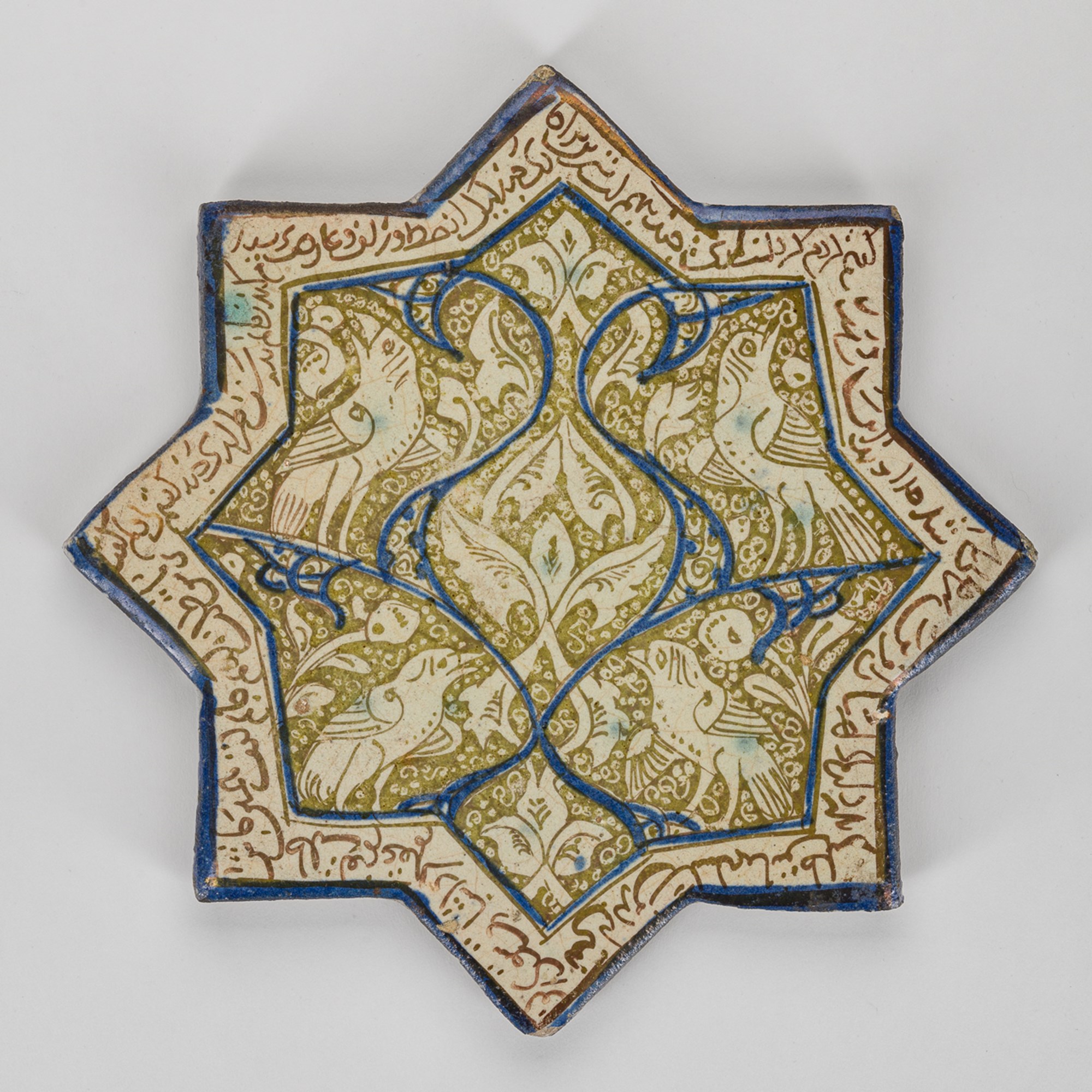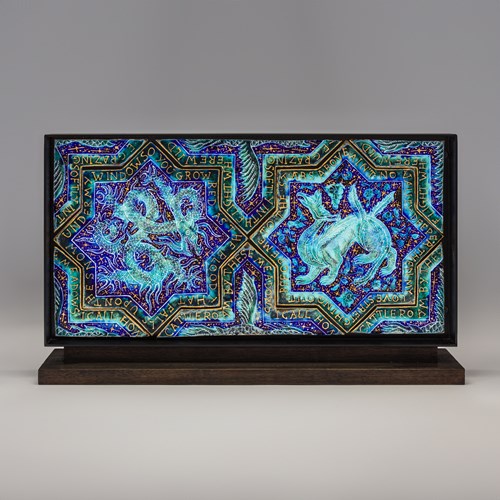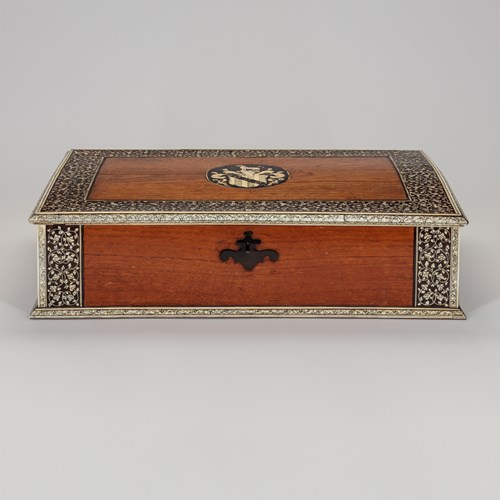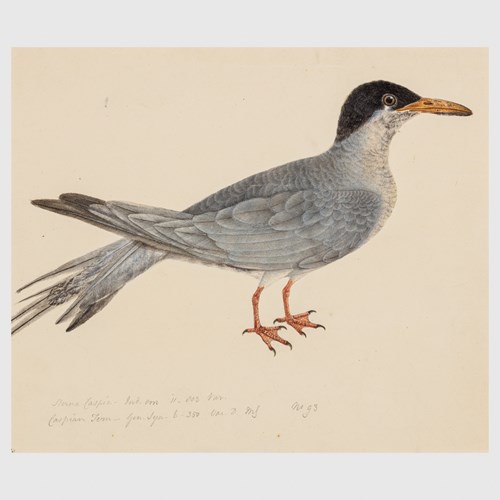Marketplace
Kashan Lustre Star Tile
This eight-pointed fritware star tile was made in Kashan, in central Iran, a town so important to the production of Persian pottery that it gives its name to the Persian word for tile (kashi).1 Tiles were produced in Kashan almost continuously from 1200 to the 1330s.2 Star-and-cross dados, of which this tile was once a part, were used to decorate secular buildings, such as funerary monuments and palaces. Illustrations of the Persian court in the Shahnameh show star-shaped tiles on the floor and walls, such as Folio 202v from the 16th century Shahnameh of Shah Tahmasp, held in the Metropolitan Museum of Art, New York (accession no. 1970.301.30).
This tile is decorated with birds and roses in reserve against a golden-brown lustre field. At the centre of the tile, two cobalt-blue split palmettes curl around pairs of acanthus leaves. Spots of turquoise are place in a circle on the tile, with one at the centre. The tile’s white border is inscribed with Persian naskhi writing in brown. Inscriptions on Kashan tiles generally come from Quranic verses relating to the function of the tile, or from epic literature such as the Shahnahmeh.3 In this case, there are two Persian quatrains from the Lawāyeḥ by the 12th-century poet 'Ayn al-Quzat Hamadani:
گفتم گردم گرد لبت باری چند
بینم لب شیرین ترا خاری چند
لیک از خط و زلف و عارضت ترسیدم
کندر مانم بدست طراری چند
I said, ‘How many times I circle around your lips!
How many thorns I see on your sweet lips!’
I was afraid, though, that because of the down (on your face), your lock and cheek,
That I would get stuck in so many ringlets!
گفتم کی دلم گفت برماش طلب
گفتم جانم گفت همین جاش طلب
گفتم عقلم کرد اشارت سوی زلف
یعنی که درین شکستگیهاش طلب
I said, ‘My heart!’, (the beloved) said ‘Look for it by us’,
I said, ‘My soul!’, he said ‘Look for it in the same place’,
I said, ‘My intellect!’, he pointed towards (his) curls,
That’s to say, ‘Look for it in these afflictions.’ 4
There is also a couplet which reads:
نگه دار بادا جهان آفرین
بهر جا کی باشد خداوند این
Protect, O World Creator,
The owner of this [tile] wherever he may be.
This couplet is frequently seen on 13th century Iranian ceramics. A Kashan lustre bowl dated to 607 AH/1210 CE in the Metropolitan Museum of Art (accession no. 61.40) bears the same inscription. For other examples and the full poem, see Oya Pancaroğlu, Perpetual Glory: Medieval Ceramics from the Harvey B. Plotnick Collection. New Haven: 2007, no. 74.
The tile bears many of the hallmarks of Kashan lustreware as described by Richard Ettinghausen. For example, the background is composed of small dots, both wings of the birds are visible, and the leaves are decorated with rows of dots along their outer edges.5 This use of colour and forms is typical of late 13th century Kashan lustre tiles. A tile dated to 665 AH (1267 CE) in the Metropolitan Museum of Art (accession no. 41.165.17) is decorated with two pairs of foxes, with very similar shaped cobalt split palmettes dividing the tile. Another tile dated to the late 13th century in the collection of the Fitzwilliam Museum, Cambridge (accession no. C.24-1934), has similar high contrast between the cobalt blue and golden background. Birds with both wings visible are depicted in reserve, with a hare at the centre of the tile. Another tile decorated with birds and vegetal motifs dating 1267 AD century is held in the same museum (accession no. C.23-1934). A sherd of a bowl from 13th century Iran in the British Museum, London (accession no. 1927,0527), features a very similar bird motif.
n.b. accession nos are clickable links
1 Porter, Venetia. Islamic Tiles. London: British Museum Press, 1995. p. 33.
2 Ibid. pp. 33-34.
3 Carboni, Stefano and Masuya, Tomoko. Persian Tiles. New York: The Metropolitan Museum of Art, 1993. p. 17, cat. 12.
4 'Ayn al-Quzat Hamadani. Risala-yi Lavayih, ed. Rahim Framanish. Tehran: 1337/1958. p. 88.
5 Jenkins, Marilyn. ‘Masterpieces from the Metropolitan Museum of Art New York’, The Arts of Islam 36 (1981). pp. 102-103.
More artworks from the Gallery






_T638839371494677624.jpg?width=500&height=500&mode=pad&scale=both&qlt=90&format=jpg)


